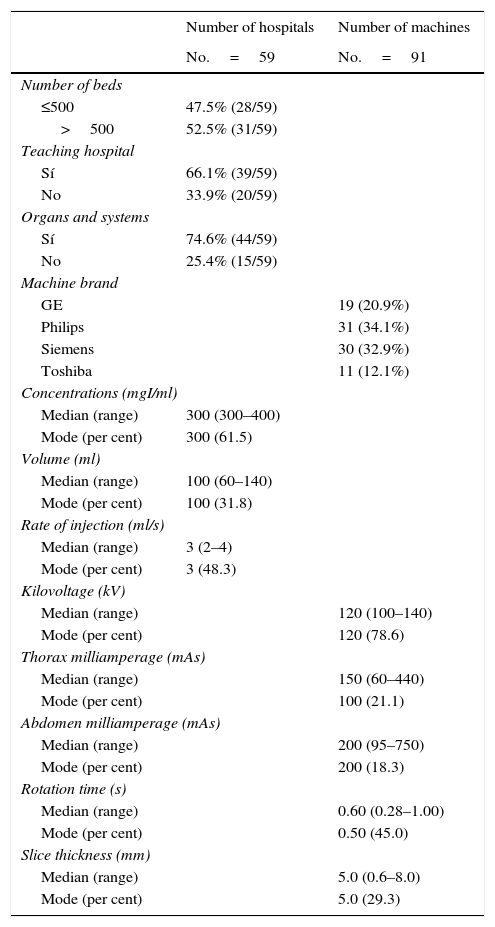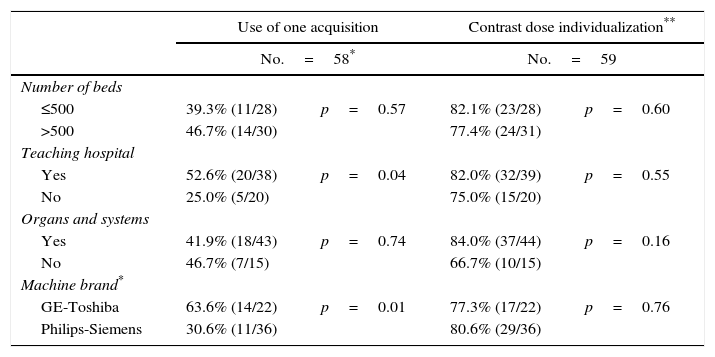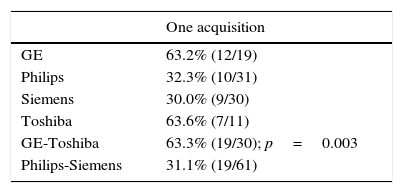To know the protocols used for staging bronchopulmonary carcinoma by computed tomography in Spain.
Material and methodsRadiologists in 129 hospitals were sent email questionnaires about the organization of their department, scanner type and manufacturer, study extension, techniques employed, and protocol for administering contrast material.
ResultsA total of 109 hospitals responded with data from 91 teams. Most hospitals were affiliated with a university, and most departments were organized by organ-systems. Scanners were from four manufacturers, and 68% had either 16 or 64 detectors. In 61% of the hospitals, the dose of contrast agent is modified only in patients with extreme body weights, and in 22% the dose is not individualized. Most hospitals do contrast-enhanced studies of the chest and upper abdomen, 42.4% through a single thoracoabdominal acquisition and 55.9% through independent chest and abdominal acquisitions; there was a significant association between these approaches and the scanner manufacturer's protocols and whether the hospital was affiliated with a university. The most commonly used technical parameters were 120kV with dose modulation and variable milliamperage.
ConclusionThere is very little variability among hospitals in the type of scanner used, the study extension, and the technical parameters used to stage bronchopulmonary carcinoma. Most centers individualize the dose of contrast agent only in extreme weights. There is a broad division between using one or two acquisitions to image the thorax and abdomen, and the number of acquisitions is related to the scanner manufacturer and whether the hospital is affiliated with a university.
Conocer los protocolos de exploración de tomografía computarizada empleados en la estadificación del carcinoma broncopulmonar en España.
Material y métodosMediante correo electrónico se enviaron encuestas a radiólogos de 129 hospitales. Las encuestas incluían preguntas sobre la organización del servicio, tipo y marca del escáner, extensión del estudio, técnica empleada y protocolo de administración del contraste.
ResultadosCincuenta y nueve hospitales respondieron con datos de 91 equipos. La mayoría de los hospitales fueron universitarios con organización por órganos y sistemas. Los modelos empleados incluyen cuatro marcas, el 68% de 16 o 64 detectores. En un 61% de los hospitales solo se modificaba la dosis de contraste en pacientes con pesos extremos y en el 22% no existía individualización. La mayoría de los hospitales realizaba un estudio del tórax y abdomen superior con contraste, un 42,4% con una única adquisición toracoabdominal y un 55,9% con dos adquisiciones independientes, existiendo relación significativa de ambos protocolos con dos marcas de escáner y con el carácter universitario del hospital. Los parámetros técnicos más empleados fueron 120kV con modulación de dosis y miliamperaje variable.
ConclusiónEl tipo de escáner empleado, la extensión del estudio y los parámetros técnicos empleados en la estadificación del cáncer broncopulmonar muestran escasa variabilidad entre los hospitales. La mayoría individualiza la dosis de contraste solo en pesos extremos. Hay una amplia división entre el empleo de una o dos adquisiciones para el tórax y el abdomen, existiendo relación entre número de adquisiciones con la marca del escáner y el carácter universitario del hospital.










